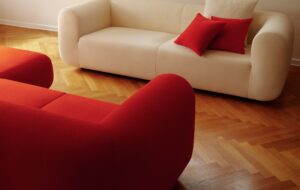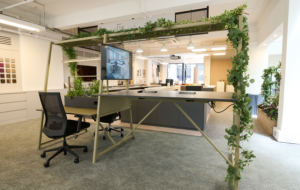|
Carol Baijings and Stefan Scholten (image: Scheltens en Abbenes) |
||
|
Scholten and Baijings were word of mouth favourites at Milan this year. The Dutch husband and wife duo presented work at three locations – with British manufacturer Established & Sons, Japanese brand Karimoku New Standard and a pop-up gallery in Lambrate; an impressive sweep for a studio no one had heard of last year. Carole Baijings and Stefan Scholten draw on craft techniques to develop their designs. Their work is riddled with narratives, and they like to decorate it with illustrations – their Wooden Travel Case is sketched with the lifespan of a tuna fish from sea to sandwich – lending a charming lyrical sensibility to their products. But the real hook is in their fantastic use of colour. “Most designers pick a colour and add it at the end,” says Scholten. So the designers exploited this oversight, and developed a niche aesthetic. Mixing powders from scratch, they create fluorescents and pastels, juxtaposing the results in a way that simultaneously hurts and delights the eye. For Total Table Design, an assignment to design a table set, “we started by drawing cardboard models, and folded them, holding the pieces together with tape,” says Scholten. Fluorescent pink, lime green and powder blue were applied. The models worked so well, the duo cast the cardboard to make moulds, translating the designs straight into porcelain – even the tape marks are visible. Such an experimental process would usually produce limited-edition work, but Scholten and Baijings’s skill is in developing products that can be mass produced. “It’s new for this kind of project that you start making straight away, but the end goal for us is to always work with industry,” Scholten says, boasting that their set of cutlery costs only €35. It’s this approach that resulted in Established & Sons putting the duo’s Amsterdam Armoire chest into production. Scholten and Baijings was asked by the Netherlands’ Zuiderzee Museum to design a collection that referenced pieces from the museum’s archive. They took to a collection of 17th-century farmers’ cabinets. The farmers would paint their furniture with objects representative of their status – so Scholten and Baijings borrowed the idea, and designed a cabinet with photography of their work laser-printed onto it. The piece isn’t cheap – and it’s such a personal object it’s hard to imagine a stranger would fork out for it. But what’s interesting is that it made it to the shop floor – this is credit to a design process that studies carefully what is feasible.
The Amsterdam Armoire (image: Scheltens en Abbenes)
Colour wood for Karimoku (image: Scheltens en Abbenes) |
Words Anna Bates |
|
|
||
















